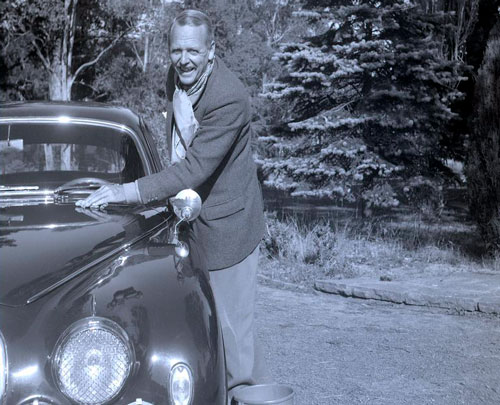Laurence Le Guay From Fighter Planes to Fashion Anna Ridley (2002) Submitted in 2002 by Anna Ridley in partial fulfilment of the requirements
for the degree of Master of Art Administration,
School of Art History and Theory, College of Fine Arts, University of New South Wales
Abstract and Introduction  | | Laurence Le Guay, collection Museum of Applied Arts and Sciences (Sydney) |
Introduction / Contents / Part 1 / Part 2 / Part 3 / Part 4 - lists / Part 5 - interview / Main Page
Abstract Laurence Le Guay was born in Sydney in 1916. After experimenting with photography while at school, he began his career in 1935 as an assistant at the Dayne Studios. During World War II he served with the RAAF in the Middle East and Europe as a photographer. On his return from the war he opened the first of many studios and began a career as a photographic illustrator specialising in fashion photography. Like Max Dupain, Le Guay leaned towards the new and exciting in photography. He embraced the emerging modern aesthetic that was developed in Germany during the 1920's and adapted to suit the Australian style. Le Guay was very involved with the Australian photographic world, founding Contemporary Photography Magazine and helping to start the Australian Centre for Photography. He was awarded a Royal Photographic Society Commonwealth Medal for his services to photography in 1963. He had complex attitudes towards photography, never claiming his work as an art form, yet encouraging others to do the most artistic work that they could. He helped to make radical changes in the way fashion was photographed, through his experimentation and use of new styles. His work and his constant promotion of photography was critical to the budding profession in Australia and he helped to pave the way for the many great artists that followed. This paper explores the background of Australian photography and looks at the way in which Le Guay's work and his aesthetic fitted into this history. It looks at all aspects of his work and tries to shed some light on this once prominent and now forgotten photographer. Introduction During my internship at the Art Gallery of New South Wales, I undertook a research project into their photography collection. One of the photographers on the list was Laurence Le Guay. I found the wide range of his works interesting, but was unable to complete the research due to time constraints. The Curator of Photography, Judy Annear, suggested that Le Guay Would be the perfect subject for a research paper, as although he is one of the most prolific photographers of his time and enjoyed a high profile very little is known about him. Le Guay was a photographer for the RAAF during World War II and some of his most famous images come from the war and the period shortly afterwards. However, it was with fashion photography that he made his biggest mark and his contributions helped to take Australian photography into the future. Unfortunately, Le Guay's photographs are not collected in any one place, and no museum or gallery has more than half a dozen works. Very few people associated with photography today know of him or his images. The standard texts on Australian photography only mention him in passing, and all have the same basic paragraph of information. However, in his time he was a well-regarded photographer who was at the forefront of commercial photography in Australia. In the course of this paper, I hope to gain some insight into Laurence Le Guay and his life and work. I wish to analyse his photographic practice in terms of his artistic achievements and look at the way in which he contributed to the growth of commercial photography in Australia through his own images and in the teaching of others. Hopefully, I will be able to show that the period of the 1930's to 1960's was the growth era of Australian photography and that Laurence Le Guay and his peers contributed immeasurably to the artistic status of photography that allows contemporary photographers to have the freedom of expression that they currently enjoy.
Introduction / Contents / Part 1 / Part 2 / Part 3 / Part 4 - lists / Part 5 - interview / Main Page
|